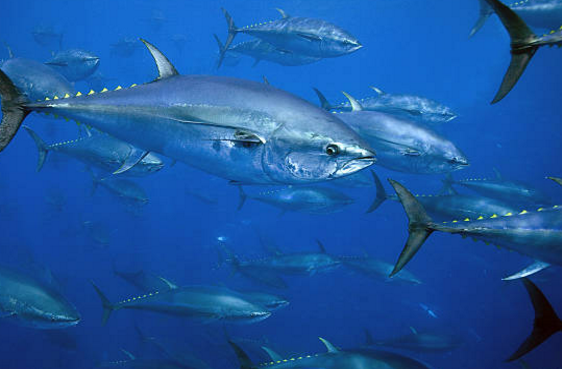This is a series that will be dedicated to raising awareness about the rapid decline of the earth’s flora and fauna. Each issue will take a close look at a specific species of plant or animal. Dissecting the issues affecting the species; conservation efforts; obstacles conservationists are trying to overcome; and how successful these efforts have been. The world is a beautiful and diverse place. However, humans are going to destroy that diversity. The International Union for Conservation of Nature (IUCN) estimates 46% of the world’s species are threatened, endangered or already extinct. The human race must act quickly and decisively if they are to reverse the terrible destruction that has occurred to the planet.
Atlantic Bluefin Tuna
The Atlantic Bluefin Tuna is one of the most incredible species on the planet. The largest of the tuna family, weighing an immense 1,500 pounds and reaching up to ten feet in length, these giants of the ocean can live up to 40 years. An apex predator, the Bluefin Tuna is built like a torpedo, exploding through the water in search of food–relying heavily on its excellent vision, which is the best of any bony fish in the sea, looking for mackerel herring and eel. The majority of Atlantic Bluefin Tuna obviously live throughout the Atlantic Ocean; however, they also have a large population in the Mediterranean Sea, which is also where the biggest fisheries are located. Once abundant throughout the Black Sea as well, the Bluefin Tuna is now extinct in that area. The World Wildlife Fund (WWF) chose the Bluefin Tuna as the sixth most-threatened species in the world. The International Union for Conservation of Nature (IUCN) estimates that 30 to 50 percent of their population has been killed over the last three generations.
Threats
The major threat to the Atlantic Bluefin Tuna is over-fishing. With the world developing a considerable appetite for sushi, tuna has become more valuable than ever. In China, the Atlantic Bluefin Tuna is similar to Kobe beef in its value. A single Tuna can be sold for over 1.75 Million dollars. There are a number of regulations around hunting this giant fish, but that does not stop what is known as “pirate fishing.” This is a fancy term for poaching, as people with no license are fishing these creatures because of the insane profits they command. The Food and Agriculture Organization of the United Nations (FAO), estimates that around 20% of the annual catch are illegal, unreported, or unregulated. This equals a staggering 10-20 Billion in annual profits for illegal fishermen. Unfortunately for this species, the use of longline fishing is a common practice in the Atlantic Bluefin Tuna’s habitat. This is the practice is extremely controversial for its bycatch. So oftentimes fishermen accidentally pull in Bluefin Tuna when they are actually hunting species such as swordfish or halibut.
One of the major issues is that not enough research has been done about these communities in regards to mating and travel patterns, making it very difficult to regulate fishing to certain times of the year. It is not uncommon for fishermen to pull in pregnant females, which is extremely detrimental to the population.
Conservation
In 1967, the International Commission for the Conservation of the Atlantic Tuna (ICCAT) was established. This commission began setting up fishing quotas throughout the Mediterranean and East Atlantic since 1982. The EU banned all driftnet fishing activities, the practice of throwing a net behind the boat and seeing what it picks up, in 2002. In 2006, ICCAT established a management plan to rebuild the stock to what it was pre-World War II by 2022. However, this plan has had a lot of hurdles, such as the refusal of Morocco to ban driftnet fishing. As per 2010, the total allowable catch of Atlantic Bluefin Tuna is 13,500 fish. ICCAT has also sponsored a research program to establish a proper fishing season while also forcing fishing ships to produce weekly catch reports. It has been a long struggle, and these programs have had varying degrees of success. If ICCAT is unable to create concrete measures that all nations agree with, these giants of the ocean might become extinct.
Main Photo:











